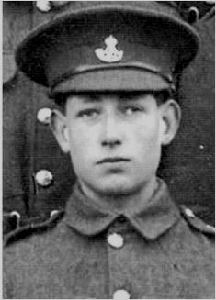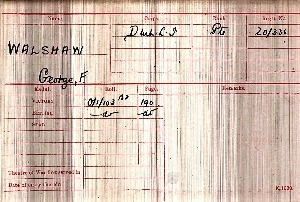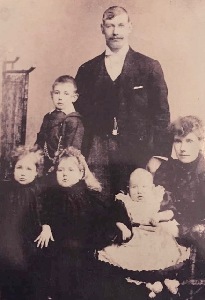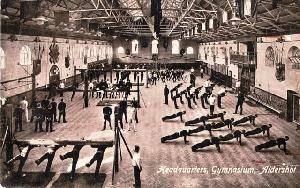
George Frederick Walshaw
Illustrated Chronicle

Medal Index Card

© Thomas and Laura Walshaw with 4 children

© Aldershot Barracks
George was born in Sunderland on the 2nd August 1897 at 12 Hume Street, Sunderland, the son of Thomas Frederick Walshaw (born 1870 at Upper Charlton Street, Marylebone, London, died 5th April 1938) and Laura Constance nee Wilkinson (born 21st June 1868 in Durham, died in March 1950), who were married in Millfield, Sunderland on the 30th April 1892.
Thomas Frederick Walshaw had initially worked as a painter before he joined Sunderland police force after his marriage in 1892. He spent several years as a detective and also as a plain-clothes officer and his name appears regularly in the local newspapers detailing his involvement in arrests and court cases in the Sunderland area. Thomas was with the force until 1918, and he was also a well-known athlete and won numerous competitions and honours. His wife Laura Constance Wilkinson lived in Durham where her parents had the Waterloo Hotel for a period of time, before she moved to Sunderland for employment in service as a domestic servant prior to her marriage.
George was one of six surviving children (all born in Sunderland) and his siblings were Thomas William (born 26th September 1892 who died on the 23rd July 1918 in WW1), Ann Adelaide (born 9th June 1894), Laura Constance (born July 1895) Isabel Cape (born 15th November 1899) and Edith Maud (born 14th July 1906). Sadly the couple’s twins John Cape and Charlotte Elliott did not survive, born in April 1902 they both died only days old.
The family can be traced through the Census returns and are found at 87 William Street in Pallion in 1901, and in the following Census living in four rooms at 82 Devonshire Street in Sunderland in 1911. George was working as a hairdresser from a relatively young age, and he continued in this profession until he enlisted in the 20th Battalion Durham Light Infantry on the 20th September 1915. Falsely giving his age as 19 years and 1 month, George was actually only eighteen years old and like many other young men had lied about his age as the legal limit for armed service overseas was 19. It is believed around 250,000 underage soldiers fought in WW1.
George was 5 feet 8 and a half inches tall, The 20th (Wearside) Battalion was raised in Sunderland and recruiting for the Battalion commenced on 19th August 1915, as part of Kitchener’s New Army. It was originally raised on the 20th June 1915 by the Mayor of Sunderland and his committee. Command of the Battalion was given to Major K. J. W. Leather of the 4th (extra reserve) Battalion Durham Light Infantry. An appeal in the Northern Echo to encourage men to enlist stated; There are special inducements for local men to join the 20th DLI. Friends who enlist in that battalion will be kept together. It is in effect another 'Pals'. Non commissioned officers will be chosen from the men and this is an opportunity which the keen will readily seize on........
The early recruits were sent to a tented camp in Wensleydale before the Battalion moved to Barnard Castle to train. They became part of the 123rd Brigade, 41st Division at Aldershot in January 1916 before leaving for France on the 4th May from Farnborough sidings on three trains to Southampton, then on board the SS Arundel, ship number 105653, landing at Le Havre.
Initially they were in the trenches around Armentieres before entering the front line for the first time on 29th May. On the 23rd August the Battalion marched to Bailleul to board a train for the Somme front, arriving at Longpre les Corps Saints and then marching to Yaucourt Bussus.
The War Diary for the 20th Battalion DLI states on the 6th to 7th September the Battalion marched from YAUCOURT BUSSUS back to LONGPRE LES CORPS SAINTS and entrained for the front. They arrived at Mericourt station and made their way to their camp located near BECORDEL (just outside of Albert). On the 9th they moved ever closer to the front, 2,000 yards nearer the firing line and on the 10th September the Battalion moved into and occupied CARLTON and SAVOY support trenches (west of LONGUEVAL) relieving the 7th Kings Liverpool Regiment of the 165th Brigade.
On the 11th September two companies of the Battalion were moved nearer the front line, One company at York Trench and the other company at Montauban. At night they had to dig a line of strong-points, 150 yards in advance of the British front line. Opposite the German trench known as the Switch. They were located in front of the Village of Flers, part of the battle of Somme. The battalion moved on the 12th to relieve the 11th Queens Battalion who were in the front line.
War Diary entry:
On the night of 12th/13th the Battalion were given orders to relieve the 11th Queens Regiment in the front line and The Queen’s would then move into support. The work already started on the new Strong Point Line was continued and completed but the day saw a number of casualties. Casualties; Lieut. J. A. Struthers wounded. Other ranks 16 wounded, 4 killed & 3 shell-shock.
They were to join the fighting at Flers on the 14th September.
It is thought that his parents were initially given hope that George would recover from the injuries he had sustained as a newspaper article appeared in the Newcastle Journal 19/09/1916 which reads: "WOUNDED Detective T. Walshaw, of Sunderland, has received a letter from the Chaplain of the D.L.I. Regiment intimating that his son, Private G. F. Walshaw, has been severely wounded. Private Walshaw is now in hospital, and making good progress."
George however died from the wounds he sustained on the 12th September 1916; he had been in France for just over four months.
George had suffered multiple gun shot wounds and he had also sustained shell or shrapnel wounds to his legs. He was transferred from 15 Corps Main Dressing Station to the 36th Casualty Clearing Station (this CCS was located at Heilly between April 1916 and March 1917) where sadly he died from his injuries the same day.
Sunderland Daily Echo and Shipping Gazette 19/09/1916
Detective-Inspector Walshaw has received an official intimation that his younger son, Pte. G. F. Walshaw, D.L.I., has died from wounds received in action on the 12th inst. Pte. Walshaw joined his battalion a year last August, before he was eighteen years of age and has been at the front since April. His brother is also at the front with the Royal Engineers.
The family had moved to 4 Bancroft Terrace in Sunderland by 1919. George’s sister Isabel also served, most probably with the Women’s Army Auxiliary Corps (WAAC) as she is listed as living at Fenham Barracks in Newcastle at this time.
His elder brother Thomas William joined the Royal Engineers, and he was also killed in action on the 23rd July 1918.
Also killed on the 12th September 1916 in the support trenches west of Longueval while serving with the 20th Battalion Durham Light Infantry were; 20/161 Private William Emery, 53 Back Church St. Seaham Harbour (stretcher bearer), who is remembered at Murton on M47.01, M47.06 and M47.09, in M47.12, page 11, and on M47.13, 20/1037 Private John Moffat Leith, 51 Washington Street, Millfield, Sunderland, who is remembered at Milfield on M44.04 and M44.08, 45774 Private William Turner Todd, Hebburn Colliery, Died of wounds, 20/1035 Private. Matthew [Nixon] Sly, who is remembered at Hendon on H123.02, Ford Street, Hendon, Sunderland and 20/539 Private. William Manners, 27 Stafford Street, Sunderland who sustained a shell wound to the abdomen on the 11th September.
With the exception of Private William Manners who is buried near George, all of the above have no known grave and are remembered on the Thiepval Memorial.
Research: Jean Atkinson/James Pasby
George Frederick Walshaw is remembered at Sunderland in The Book of Remembrance S140.048 part 02 and in the Battalion History 20th Durham Light Infantry D47.148a and the Book of Remembrance D47.013c page 241.

